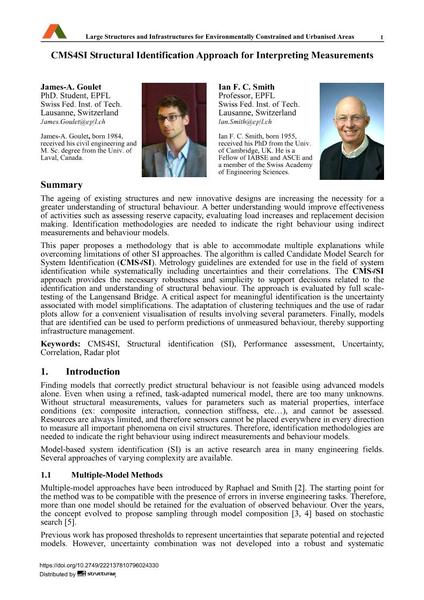CMS4SI Structural Identification Approach for Interpreting Measurements

|
|
|||||||||||
Détails bibliographiques
| Auteur(s): |
James-A. Goulet
Ian Smith |
||||
|---|---|---|---|---|---|
| Médium: | papier de conférence | ||||
| Langue(s): | anglais | ||||
| Conférence: | IABSE Symposium: Large Structures and Infrastructures for Environmentally Constrained and Urbanised Areas, Venice, Italy, 22-24 September 2010 | ||||
| Publié dans: | IABSE Symposium Venice 2010 | ||||
|
|||||
| Page(s): | 224-225 | ||||
| Nombre total de pages (du PDF): | 8 | ||||
| Année: | 2010 | ||||
| DOI: | 10.2749/222137810796024330 | ||||
| Abstrait: |
The ageing of existing structures and new innovative designs are increasing the necessity for a greater understanding of structural behaviour. A better understanding would improve effectiveness of activities such as assessing reserve capacity, evaluating load increases and replacement decision making. Identification methodologies are needed to indicate the right behaviour using indirect measurements and behaviour models. This paper proposes a methodology that is able to accommodate multiple explanations while overcoming limitations of other SI approaches. The algorithm is called Candidate Model Search for System Identification (CMS4SI). Metrology guidelines are extended for use in the field of system identification while systematically including uncertainties and their correlations. The CMS4SI approach provides the necessary robustness and simplicity to support decisions related to the identification and understanding of structural behaviour. The approach is evaluated by full scale- testing of the Langensand Bridge. A critical aspect for meaningful identification is the uncertainty associated with model simplifications. The adaptation of clustering techniques and the use of radar plots allow for a convenient visualisation of results involving several parameters. Finally, models that are identified can be used to perform predictions of unmeasured behaviour, thereby supporting infrastructure management. |
||||
